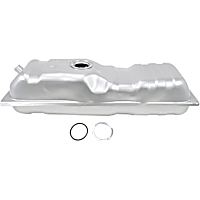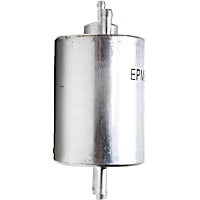The function of the fuel system is to store and supply fuel to the cylinder chamber where it can be mixed with air, vaporized, and burned to produce energy. The fuel, which can be either gasoline or diesel is stored in a fuel tank. A fuel pump draws the fuel from the tank through fuel lines and delivers it through a fuel filter to either a carburetor or fuel injector, then delivered to the cylinder chamber for combustion.
Gasoline
Gasoline is a complex blend of carbon and hydrogen compounds. Additives are then added to improve performance. All gasoline is basically the same, but no two blends are identical. The two most important features of gasoline are volatility and resistance to knock (octane). Volatility is a measurement of how easily the fuel vaporizes. If the gasoline does not vaporize completely, it will not burn properly (liquid fuel will not burn).
If the gasoline vaporizes too easily the mixture will be too lean to burn properly. Since high temperatures increase volatility, it is desirable to have a low volatility fuel for warm temperatures and a high volatility fuel for cold weather. The blends will be different for summer and winter fuels. Vapor lock which was a persistent problem years ago, exists very rarely today. In today’s cars the fuel is constantly circulating from the tank, through the system and back to the tank. The fuel does not stay still long enough to get so hot that it begins to vaporize. Resistance to knock or octane is simply the temperature the gas will burn at. Higher octane fuel requires a higher temperature to burn. As compression ratio or pressure increases so does the need for higher octane fuel. Most engines today are low compression engines therefore requiring a lower octane fuel(87). Any higher octane than required is just wasting money. Other factors that affect the octane requirements of the engine are: air/fuel ratio, ignition timing, engine temperature, and carbon build up in the cylinder. Many automobile manufacturers have installed exhaust gas re-circulation systems to reduce cylinder chamber temperature. If these systems are not working properly, the car will have a tendency to knock. Before switching to a higher octane fuel to reduce knock, make sure to have these other causes checked.
Diesel
Diesel fuel, like gasoline is a complex blend of carbon and hydrogen compounds. It too requires additives for maximum performance. There are two grades of diesel fuel used in automobiles today: 1-D and 2-D. Number 2 diesel fuel has a lower volatility and is blended for higher loads and steady speeds, therefore works best in large truck applications.Because number 2 diesel fuel is less volatile, it tends to create hard starting in cold weather. On the other hand number 1 diesel is more volatile, and therefore more suitable for use in an automobile, where there is constant changes in load and speed. Since diesel fuel vaporizes at a much higher temperature than gasoline, there is no need for a fuel evaporation control system as with gasoline. Diesel fuels are rated with a cetane number rather than an octane number. While a higher octane of gasoline indicates resistance to ignition, the higher cetane rating of diesel fuel indicates the ease at which the fuel will ignite. Most number 1 diesel fuels have a cetane rating of 50, while number 2 diesel fuel have a rating of 45. Diesel fuel emissions are higher in sulfur, and lower in carbon monoxide and hydrocarbons than gasoline and are subject to different emission testing standards.

Fuel Tank
Tank location and design are always a compromise with available space. Most automobiles have a single tank located in the rear of the vehicle. Fuel tanks today have internal baffles to prevent the fuel from sloshing back and forth. If you hear noises from the rear on acceleration and deceleration the baffles could be broken. All tanks have a fuel filler pipe, a fuel outlet line to the engine and a vent system. All catalytic converter cars are equipped with a filler pipe restrictor so that leaded fuel, which is dispensed from a thicker nozzle, cannot be introduced into the fuel system. All fuel tanks must be vented.Before 1970, fuel tanks were vented to the atmosphere, emitting hydrocarbon emissions.Since 1970 all tanks are vented through a charcoal canister, into the engine to be burned before being released to the atmosphere. This is called evaporative emission control and will be discussed further in the emission control section. Federal law requires that all 1976 and newer cars have vehicle rollover protection devices to prevent fuel spills.
Fuel Lines
Steel lines and flexible hoses carry the fuel from the tank to the engine. When servicing or replacing the steel lines, copper or aluminum must never be used. Steel lines must be replaced with steel. When replacing flexible rubber hoses, proper hose must be used. Ordinary rubber such as used in vacuum or water hose will soften and deteriorate. Be careful to route all hoses away from the exhaust system.
Fuel Pumps
Two types of fuel pumps are used in automobiles; mechanical and electric. All fuel injected cars today use electric fuel pumps, while most carbureted cars use mechanical fuel pumps. Mechanical fuel pumps are diaphragm pumps, mounted on the engine and operated by an eccentric cam usually on the camshaft. A rocker arm attached to the eccentric moves up and down flexing the diaphragm and pumping the fuel to the engine. Because electric pumps do not depend on an eccentric for operation, they can be located anywhere on the vehicle. In fact they work best when located near the fuel tank.
Many cars today, locate the fuel pump inside the fuel tank. While mechanical pumps operate on pressures of 4-6 psi (pounds per square inch), electric pumps can operate on pressures of 30-40 psi. Current is supplied to the pump immediately when the key is turned. This allows for constant pressure on the system for immediate starting. Electric fuel pumps can be either low pressure or high pressure. These pumps look identical, so be careful when replacing a fuel pump that the proper one is used. Fuel pumps are rated by pressure and volume. When checking fuel pump operation, both specifications must be checked and met.
Fuel Filters
The fuel filter is the key to a properly functioning fuel delivery system. This is more true with fuel injection than with carbureted cars. Fuel injectors are more susceptible to damage from dirt because of their close tolerances, but also fuel injected cars use electric fuel pumps. When the filter clogs, the electric fuel pump works so hard to push past the filter, that it burns itself up. Most cars use two filters. One inside the gas tank and one in a line to the fuel injectors or carburetor. Unless some severe and unusual condition occurs to cause a large amount of dirt to enter the gas tank, it is only necessary to replace the filter in the line.
Where to Get New Fuel System Parts for Your Vehicle
Driving around with damaged fuel system components never ends well. The next thing you know, you’re out of fuel even after recently topping up your tank. Replace damaged fuel lines, pumps, and filters, and shop for OE-grade replacement here at CarParts.com. We have all the fuel system parts you need to get your daily driver back on the road as soon as possible.
Simply enter your vehicle’s year, make, and model into our vehicle selector to start browsing compatible parts for your ride. We only offer products that pass the high quality standards of our team of industry professionals, so you don’t have to worry about getting subpar replacement parts.
Thanks to our strategically located warehouses across the US, you can get your order delivered straight to your doorstep in as fast as two business days. What’s more, is that all our products come with a low-price guarantee, so you don’t have to worry about breaking the bank or your repairs. Shop now, and check out securely in a matter of minutes.
Don’t let your vehicle gather dust in the garage because of damaged fuel system parts. Shop at CarParts.com today!
Products Mentioned in this Guide
Any information provided on this Website is for informational purposes only and is not intended to replace consultation with a professional mechanic. The accuracy and timeliness of the information may change from the time of publication.


 Fuel Tank
Fuel Tank
 Fuel Filter
Fuel Filter














